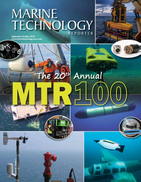Marine Technology Reporter Blogs - optic
Future ROV Technology - Subsea Wireless Control

Wireless subsea technology is becoming a fundamental part of the oil and gas industry worldwide. Back in 2010, Woods Hole Oceanographic Institution (WHOI) scientists and engineers announced testing of an undersea optical communications system that, complemented by acoustics, enabled a virtual revolution in high-speed undersea data collection and transmission. Acoustic techniques were developed, which are now the predominant mode of underwater communications between ships and smaller, autonomous and remote control vehicles. However, acoustic systems, although capable of long-range communication, transmit data at limited speeds and delayed delivery rates due to the relatively slow speed of sound in water.
Future ROV Technology - Subsea Wireless Control
Wireless subsea technology is becoming a fundamental part of the oil and gas industry worldwide. Back in 2010, Woods Hole Oceanographic Institution (WHOI) scientists and engineers announced testing of an undersea optical communications system that, complemented by acoustics, enabled a virtual revolution in high-speed undersea data collection and transmission. Acoustic techniques were developed, which are now the predominant mode of underwater communications between ships and smaller, autonomous and remote control vehicles. However, acoustic systems, although capable of long-range communication, transmit data at limited speeds and delayed delivery rates due to the relatively slow speed of sound in water.
Future ROV Technology - Subsea Wireless Control
Wireless subsea technology is becoming a fundamental part of the oil and gas industry worldwide. Back in 2010, Woods Hole Oceanographic Institution (WHOI) scientists and engineers announced testing of an undersea optical communications system that, complemented by acoustics, enabled a virtual revolution in high-speed undersea data collection and transmission. Acoustic techniques were developed, which are now the predominant mode of underwater communications between ships and smaller, autonomous and remote control vehicles. However, acoustic systems, although capable of long-range communication, transmit data at limited speeds and delayed delivery rates due to the relatively slow speed of sound in water.
Future ROV Technology - Subsea Wireless Control
Wireless subsea technology is becoming a fundamental part of the oil and gas industry worldwide. Back in 2010, Woods Hole Oceanographic Institution (WHOI) scientists and engineers announced testing of an undersea optical communications system that, complemented by acoustics, enabled a virtual revolution in high-speed undersea data collection and transmission. Acoustic techniques were developed, which are now the predominant mode of underwater communications between ships and smaller, autonomous and remote control vehicles. However, acoustic systems, although capable of long-range communication, transmit data at limited speeds and delayed delivery rates due to the relatively slow speed of sound in water.


 August 2025
August 2025



